Here are our tomato plants and their friends ONE MONTH AGO:
And here they are now:
They’ve gotten huge, heavy, and they still have a ways to go before they start fruiting. Plus we have forty of them! Our neighbor Daniel grew them from seed. We helped transplant them, and planted beneficial companion plants all around: marigolds, nasturtiums, chives, basil, garlic.
But tomato plants need to be staked and/or somehow supported, and they need as little foliage to touch the ground as possible—this reduces disease and pests. We thought about buying tomato cages, but with 40 plants, that could get expensive. We’re trying to DIY as much of this garden as possible, so Daniel knocked together a wooden structure out of the scrap wood we have lying around. Then, we had to get creative.
With nothing more than small metal eye hooks ($5.98 for a box of 40 from Lowe’s) and a spool of nylon thread (I didn’t buy this so I don’t know how much it cost), we made a sort of zigzag trellis. Daniel bought clips he saw in a Youtube video (plastic, but reusable, and about $20 for a big box). We clipped the first bed to the trellis on Thursday night, stopping when it got dark.
It’s been raining a lot, so in a weather break yesterday Bea and I went back to the garden to work on the second bed. These tomatoes (mostly Big Mamas and Paul Robesons) were much harder to wrangle, and Bea and I had to get more innovative still, using twine to tie the thick stems and rigging up a sort of marionette system for the plants.
I asked Bea if they ever work with plants and biological challenges in STEM class at school. “No, never,” she told me. “It’s always technology and engineering.”
But this was engineering plus biological sciences—and a real-world problem to solve. Down the road there will be pest control, soil amendments, and lots of opportunities for figuring out the best weeding practices. Then there will be all that tomato math.
I wish Bea and Harriet’s teachers had time to do things like this so that all the kids at the girls’ school could garden, and so STEM could look a little more like solving real world problems. But they definitely do not—the classes are large, and the pressures are huge—and I’m loathe to suggest things that make their hard jobs even harder. I know friends and colleagues send their kids to private and charter schools where the kids are probably gardening on the regular! And going on field trips every month! Etc, etc.
But I know that public schools are best, and that what my kids get out of them, and what the community gets from all of us coming together to learn in a space that is (ideally) welcoming to everyone, and (ideally) not divided by race or class or ideology or ability, is more important than my wishful thinking.
Speaking of school, here’s another real-world math problem to solve:
We’re trying to convince the County Commissioners to raise Chatham teacher supplements by $2700. They have come back with a $1200 recommendation from the County Manager. That’s not enough! We know the county needs to fully fund the School Board’s budget, as they have in the past, so that we can retain our wonderful teachers, plus recruit new teachers for open positions. North Carolina’s abysmal teacher pay (thanks to years of Republican underfunding, we rank near the bottom, nationally) has led to an 11.5% attrition rate. Chatham’s attrition rate is even worse, at 13.6%. About 20% of those leaving Chatham are headed to new jobs in better-paying districts.
Some of us (hopefully, many of us) will be at the next two County Commissioner meetings, giving public comment on the need for these raises and showing support for our wonderful public school educators. If you live in Chatham, these public hearings are happening on Monday, May 20th at 6pm in Pittsboro’s historic courthouse and Tuesday, May 21 at 6pm at the Siler City town hall. You can find details and sign up for public comments here. (If you can’t be there, you can also submit public comments in writing.)
To get ready for this meeting, the girls and I made reusable signs that I think would work great in many contexts, especially when you’re talking about education. Using the same DIY, low-cost ethic we apply to the garden, we created signs made to look like chalkboards. Like chalkboards, you can wipe them down and reuse them for new messages, over and over!
Here’s what you do:
1. Get some cardboard. Our friend Jennifer asked her neighbors in Briar Chapel for stuff headed to the recycling bin, and I scooped them up.
2. Cut the cardboard into rectangles of varying sizes, then paint with chalkboard paint. You might need two coats.
3. Some of the boxes came with corner supports that looked like chalk holders—we cut those and glued them to the sign bottoms.
4. Use chalk or sidewalk chalk to write your message.
5. Erase with a cloth and use again!
And, in case you were wondering, we had a great time at the ropes course on Mother’s' Day! It was both scarier and more fun than we expected. We went to this one.
How about you, Frog Troublers? Have you solved any real-world problems lately? Do you have any suggestions about growing tomatoes?
Also, please check out this great post about a recent visit to the Pie Factory (what we call FTT headquarters) by our dear friend Elaine at Stranger and Stranger, which you should totally subscribe to.

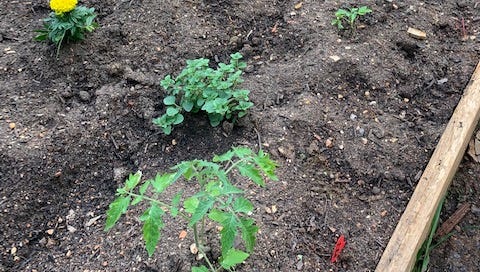



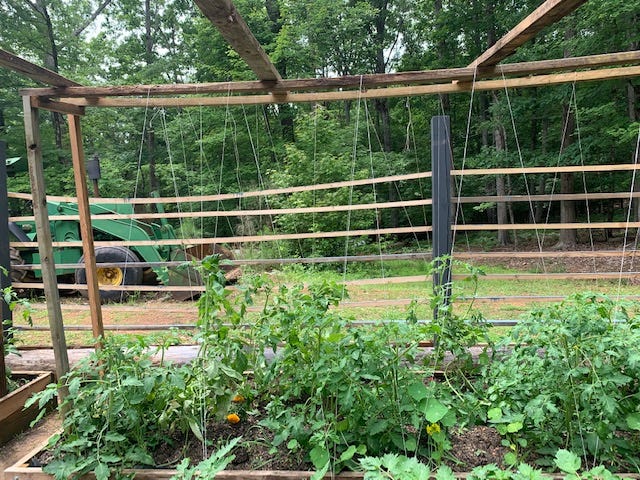
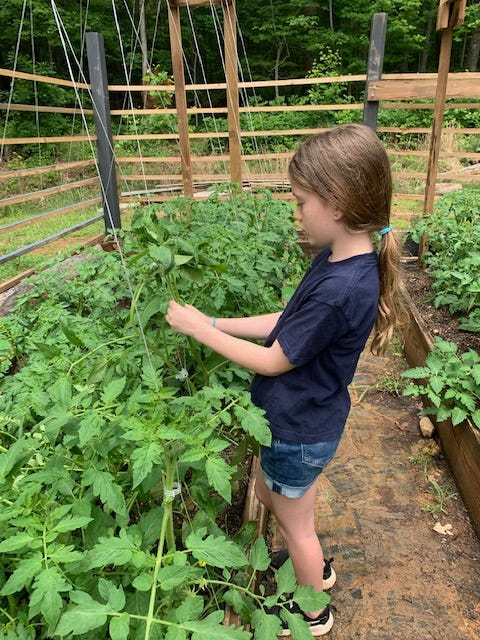
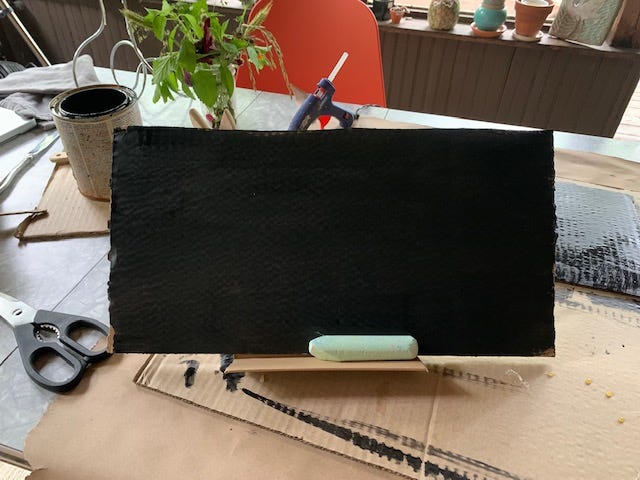
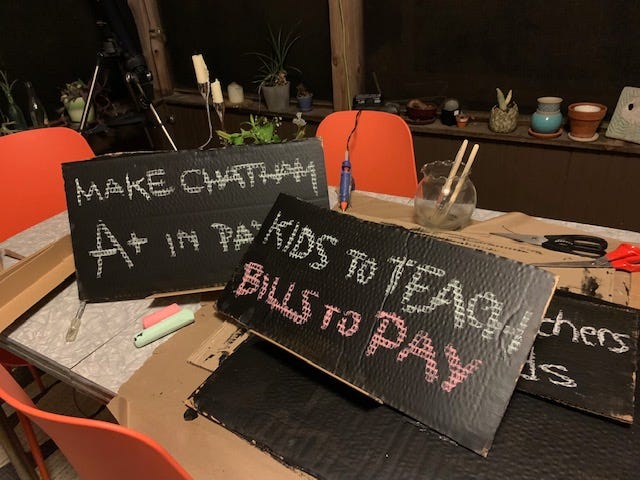

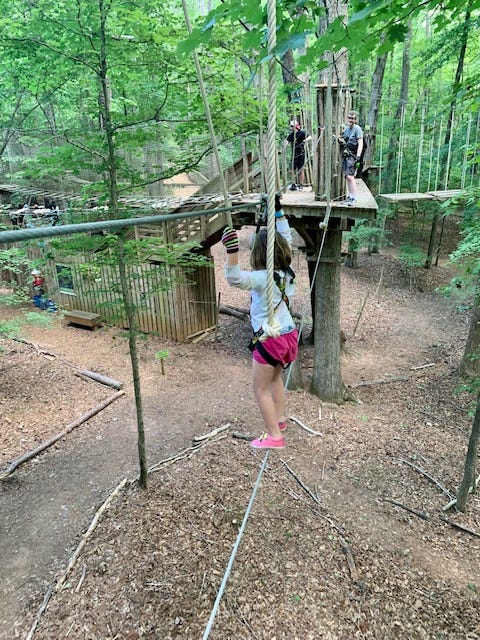
Your staking system for the tomatoes is pure genius as are the chalkboard signs! I certainly agree with everything you expressed about public education. Thank you for all that you do in FTT to educate, inspire ,and motivate us to become better stewards of the earth, and more engaged citizens. Thank you also for many wonderful ideas for projects we parents and grandparents can do with our little ones. My love to all.
Yikes! on the ropes course, but who knows, if it went well, I might join the circus. Great post,